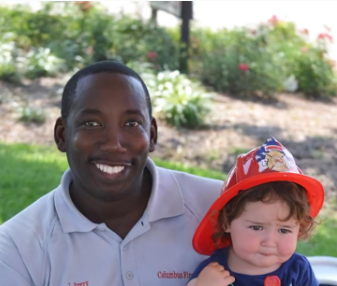
Fresh out of high school, James Avery had no idea what he wanted to do in life. “I didn’t know what I wanted to do after high school,” Avery said. “I was thinking at first about the military because that’s what a lot of my friends did. But I decided to go to college at Mississippi State and got my degree there. I had a few jobs after I graduated, but they weren’t really what I wanted to do.”
When a close friend was hired as a firefighter at Columbus Fire and Rescue in Mississippi, he encouraged Avery to apply for a position. After achieving a perfect score on the written exam, Avery began his career as a firefighter in 2000 and became certified as an Emergency Medical Technician (EMT) two years later, passing the National Registry of Emergency Medical Technicians exam and maintaining his certification for 20 consecutive years!
Technically, Avery never chose Emergency Medical Services (EMS), but as fate would have it, EMS chose him. Two years after becoming a firefighter, certification requirements for fire personnel expanded beyond the traditional training to include EMS; a move Avery has embraced wholeheartedly. “Well, early in my career as a firefighter, they switched to include EMS as part of our required training,” said Avery. “My interest in medicine just sort of took off from there."
Over the years, Avery has achieved additional certifications that supplement his EMS training, including underwater dive rescue, hazmat training, and structural collapse search and rescue.
“9 out of 10 times, we'd be the first ones to arrive on the scene of an accident, and we didn’t have the medical training required to give patients the best possible chance of survival,” Avery recalls. “We’re out there trying to maintain the pace in a life-threatening environment, but quite frankly, we were underqualified. Adding EMS training and becoming certified changed everything; we can now save lives and provide crucial medical assistance immediately upon arrival. Every second counts; it excites me.”
For Avery, the decision to maintain his certification with the National Registry for 20 consecutive years is a no-brainer. “Being certified lets us know we are a part of something; I mean, we are on a larger scale because of certification that has opened doors within the EMS community that would not be possible without it.” But it’s more than that, he says. “In my eyes, being registered means that I have met and exceeded a certain standard required not just locally but nationally. I can go anywhere and apply this knowledge to anything, and because I maintain this level of certification, people know that I hold myself to that standard to be the best I can be.”
Avery also believes in the importance of younger EMS professionals taking advantage of the resources available and staying connected through continued National Registry certification. “My advice to these younger providers is to learn all you can and to keep abreast of constant changes happening all the time in public service.” Avery continued, “Look at the American Heart Association, they have changed CPR requirements more than once, and they aren’t alone. The Registry helps me stay current on what’s changing and what those changes mean for my department and me.”
If you were to go back in time and ask that young graduate to predict a memorable day on the job for his future self, he most likely wouldn’t tell you that it involved a fatal car accident, but as Avery knows all too well, fate had other plans for him.
It was his first fatal motor vehicle accident; the car had flipped several times and lay overturned on the side of the road. As he approached the chaotic scene, he could see that the driver was unscathed, and another occupant had taken off running into the woods with first responders in quick pursuit.
The sirens and air horns seemed distant as his eyes moved to the third passenger, who had been thrown from the vehicle and lay motionless on the pavement. “He had landed in such a way that most of his face and forehead were completely missing. He was face down and had slid for several feet before coming to a stop,” Avery recalls. “Seeing that, I knew this was not television; this was real.”
He knew at that heart-wrenching moment that he was meant for this, to save lives. "To see that, one person relatively unscathed with, you know, a scratch on their arm to seeing a man not breathing on the asphalt puts it all into perspective. That has had a lasting impression on me.”
From that day on the road all those years ago and every day since, Avery has gone above and beyond in service to his community. Choosing to stay current with his National Registry certification allows him to remain committed to always being ready for anything in a fast-paced and ever-changing field.
Read More Articles In This Series
- Bill Wood - "50 Consecutive Years Of National Registry Certification"
- Justin Solobay - "A Night To Remember"
- Jessica Cervantez - "Be A Rock In The Moment People Are Falling Apart"
- James Avery - "An Unexpected Destiny - How One EMS Provider Discovered Sometimes Fate Has Other Plans"
- Tom Perreault - "43 Years Down and a Lifetime to Go"
